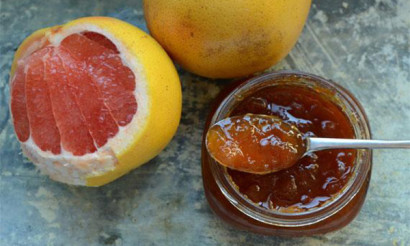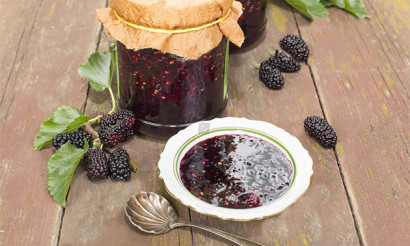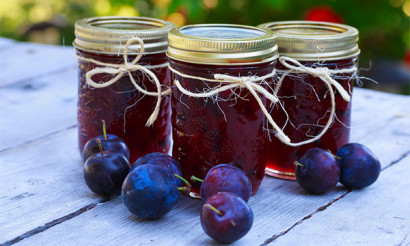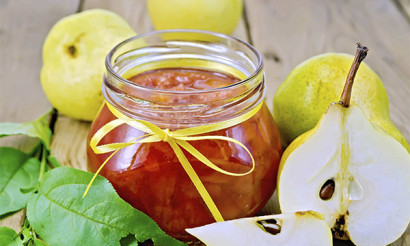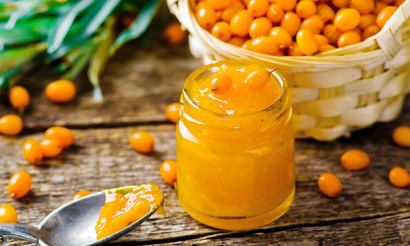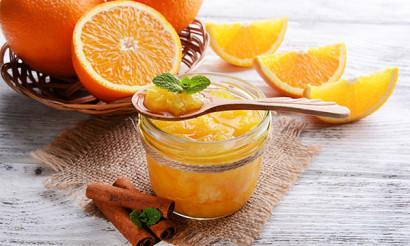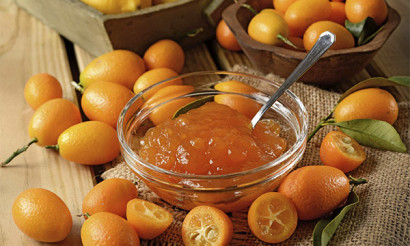Feijoa Jam: 10 recipes
Feijoa is a subtropical plant, the fruits of which are incredibly healthy for both raw and in various dishes and preparations for the winter. Every fall feijoa appear on store shelves grown in the Caucasus and in the Krasnodar Territory, but so far they have not gained due popularity in Russian cuisine. Meanwhile, they deserve it, so you should keep a jar of feijoa jam in the refrigerator for anyone who wants to avoid seasonal illnesses.
What is feijoa
Large green feijoa berries are the fruits of the tree of the same name (its botanical name is Acca sellowiana). In the wild, it grows in the mountains of Uruguay, Brazil, Colombia, in the north of Argentina. But back in the 1890s, the tree was introduced into the Russian Empire, and miraculously took root in its southern regions. In Europe, feijoa is grown in Spain, in France, in Sicily, in the USA - in the state of California. Major suppliers of these berries are Australia and India. Feijoa grown in Georgia or Azerbaijan are most often sold in Russian stores, less often in Crimea or Sochi.
These are juicy dark green berries, at the top of which sepals remain. Most varieties have an elongated oval shape, although they are round and cubar. The weight of one berry can be 15-60 g, they usually reach a length of 5 cm, but sometimes larger specimens are also found. It is clear that for compote and jam it is better to take ripe berries, with large flesh transparent on the cut. The peel of ripe feijoa remains dark green, although there are varieties with a yellowish tint. It can be smooth and bumpy, and have an anthocyanin coating - all of these are normal options.
The taste and aroma of this berry is hard to describe. The fact is that it resembles at the same time pineapple, and kiwi, and garden strawberries. That is, it is sweet and fresh, and a little bit sour.
The benefits of feijoa jam for the body
Feijoa has an unusual but pleasant taste. And most importantly - this is a real storehouse of vitamins. And raw, the fruits of this plant are sold in stores and markets throughout the fall. At the same time, feijoa, due to its low calorie content, is welcomed by nutritionists, and properly prepared jam from it will also be useful.
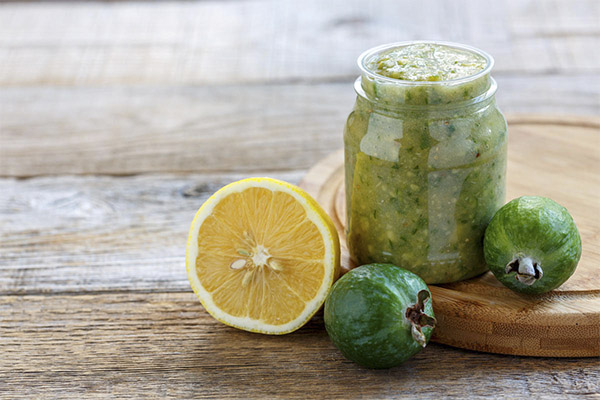
The fact is that feijoa contains a lot of iodine. By this indicator, the berries are quite comparable with seafood. Since they are grown most often in coastal areas, sea breezes bring with them an additional amount of volatile iodine. So such fruits are of high value. Official medicine even recommends using these berries for certain thyroid gland pathologies, for example, for hypothyroidism. Iodine is necessary for the production of thyroxine and other thyroid hormones. Even a healthy person needs it to regulate metabolism. Iodine deficiency leads to chronic fatigue and depression. Children need it for normal mental development.
However, with prolonged heat treatment, most of the iodine is destroyed. It is preserved only by the so-called “living” jam, the recipe of which will be discussed below.
The beneficial properties of feijoa jam are also due to other substances present in these fruits. These include malic acid, pectins (they normalize digestion and help eliminate toxins), as well as B vitamins, including folic acid - they are necessary both for metabolism and for the normal functioning of the nervous system. Berries are also beneficial in their high content of ascorbic acid: almost as much vitamin C in feijoa as in mandarins. And this is another reason why “living” jam, which has not undergone heat treatment, is more useful than classical.
Finally, feijoa jam contains vitamin P. It not only lowers blood pressure, but generally improves the state of the vascular walls. The astringent taste of berries and jam from them is given by the antioxidants polyphenols contained in the skin. These are mainly tannins and catechins, which are present, for example, in green tea. They have an anti-inflammatory effect, serve as protection against cancer, and prevent premature aging. For this reason, when preparing jam, it is not recommended to get rid of the peel.
Thus, the feijoa jam:
- It has a tonic and restorative effect.
- It serves as the prevention of cancer.
- Enhances natural immunity.
- Improves the condition of blood vessels.
- Provides normal kidney function and removes toxins from the body.
- Prevents depression, helps relieve stress and get rid of chronic fatigue.
- It has anti-inflammatory properties.
- Normalizes metabolism and promotes weight loss.
- It has an antibacterial effect (it is proved that the substances contained in these berries kill staphylococcus aureus and E. coli).
Due to the unique chemical composition of berries, “live” jam is recommended for pregnant women to provide the body with all useful substances and vitamins. It is also considered an excellent natural cure for atherosclerosis and hypertension. Thanks to its antibacterial properties, it helps with pyelonephritis.
How to make feijoa jam: recipes
To make the jam tasty and healthy, you first need to choose high-quality feijoa fruits. As already mentioned, it is better to take large ones, carefully inspecting them so that there are no cracks or dark spots on the skin. But the glossy peel should not be, this suggests that the fruit has not yet ripened (another sign of this is the green stalk). Unfortunately, very often the berries that are sold in stores are just unripe. The fact is that it is difficult to transport the berries, since in the ripe state they become soft.
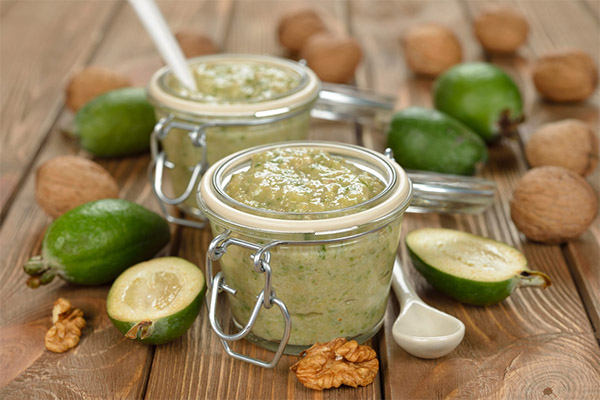
By the way, this is another way to check their ripeness. Ripe fruits are soft, if you gently squeeze them with your fingers, the pulp lends itself well to pressure. If the fetus is solid and does not respond to compression, it is not ripe. There is nothing wrong with that, at home, after lying a couple of days in a warm place, the berries ripen.
A more reliable way of checking is to evaluate the flesh on the cut. Ripe fruits have a transparent pulp of jelly consistency. Closer to the peel, it remains denser (by the way, in cosmetology it is used for scrub and masks). At the same time, the peel remains green, its color does not say anything about ripeness. Unripe berries have a greenish or milky white flesh. If it has a brown tint, this suggests that the berries are overripe. It is not worth eating them, they can trigger diarrhea. They are not suitable for jam for the same reason. However, you can get juice from them, which is used in cosmetology.
Live Jam
"Live" jam, which does not pass heat treatment, is considered the most useful. For its preparation you need berries mixed with sugar in equal proportions. If you like the sour taste, you can take 0.7 kg of sugar per 1 kg of feijoa, that is, 30% less.
The fruits need to be washed, get rid of the tops and stalks. Then the berries should be passed through a meat grinder or chopped in a blender so that they do not oxidize from contact with the metal, add lemon. After that, they need to be filled with sugar, mix until it dissolves and put in sterile jars, tightly closing with a polymer lid.
There are many recipes for making “live” feijoa jam, which does not require heat treatment. Here are just a few of them:
- Feijoa jam with walnuts. For 1 kg of berries they take the same amount of sugar, one lemon, walnuts - to taste. The berries are washed and scalded with freshly boiled water, then chopped in a blender directly with the skin and mixed with sugar and chopped nuts and lemon. Sugar in the recipe can be replaced with honey.
- Feijoa jam with ginger and lemon. For 500 g of berries take the same amount of sugar, 1 lemon, 3 tbsp. spoons of grated ginger root. The berries are washed, dried, stalks are cut, then chopped in a blender with ginger and sugar. After that, it can be stored in the refrigerator for 2-3 months. There is a second option - after grinding in a blender, the mass is placed in a saucepan, 0.5 cup of water is added, boiled for 10-15 minutes and closed in sterile jars. This jam can be stored until the end of winter, and it does not even need to be kept in the refrigerator.
- Feijoa and apple jam. For 1 kg of feijoa take the same amount of apples, 1 kg of sugar and 1 lemon (so that the fruits and berries do not darken). Apples and feijoa are washed, without peeling them. Cut the apples, remove the seeds, remove the tops and stalks of the berries, chop coarsely. Lemon can be cut into slices and remove the seeds. All ingredients are crushed in a blender and mixed with sugar, and then laid out in containers.
- Feijoa, kiwi, orange and grape jam. For 300 g of feijoa berries, take two kiwi fruits, one orange, 100 g of grape berries, zest of one lemon. Sugar is added to taste, given that grapes contain a lot of glucose. Fruits should be washed and peeled. To reduce the hassle of kiwi, you can cut it into halves and remove the pulp with a spoon. The orange is divided into slices and the seeds are extracted. All of the listed ingredients, except grapes, are passed through a meat grinder or whipped in a blender. The grape berries are left intact. They are added to the mass with sugar, mixed thoroughly and then the dessert is laid out in jars. It can be stored in the refrigerator for 2-3 weeks, and thanks to the lemon peel it will not lose its beautiful shade.
Feijoa can be combined with other fruits and nuts (for example, hazelnuts or almonds). The only exception is peanuts.
These berries combine very well with nectarine. Some housewives cook feijoa and with plums. But feijoa is also not cooked with strawberries, although there are recipes for tinctures based on these two berries. The fact is that this jam is oxidized at an accelerated rate and very quickly darkens. You can add less sugar to the recipe, then the dessert will be sour. You can regulate its sweetness with the help of honey and cinnamon. From spices, vanilla is also sometimes added to jam.
Feijoa and cranberry jam
A very beautiful color is obtained from feijoa and cranberry jam - thanks to the acid contained in the berries, the product does not lose its noble dark red color. For 1 kg of feijoa, you need to take 0.5 kg of cranberries and 1 kg of sugar (if the berries are too acidic, you can add honey). All this is whipped in a blender until smooth. Then the jam is poured into jars and covered with a lid. Cranberries contain components, thanks to which this composition by itself thickens a little and gels (as in the case of redcurrant berries), therefore, it is not necessary to boil it, it may acquire too dense consistency. In addition, cranberries contain a lot of vitamin C, which can be destroyed by heat treatment.
Classic recipes
You can also make jam according to the classical scheme, involving the thermal treatment of the product. It contains less nutrients, and quite a lot of sugar is added to it, but even such a product brings certain health benefits. For example, experienced chefs recommend the following varieties of this dessert:

- Classic feijoa jam. To do this, take berries and sugar in a ratio of 1: 1. The fruits are washed, dried and chopped, but the peel is not removed. The crushed berries are sprinkled with sugar, add 0.5 cups of water, mix, bring to a boil, then cook on low heat for 5-7 minutes. After that, let the jam cool, bring it to a boil again and cool. Finally, the finished product is poured into pre-steamed cans and sealed with lids.
- Whole feijoa jam. To do this, you need 0.5 kg of berries, a glass of sugar, 1 tbsp. a spoonful of brandy or brandy, 0.5 l of water. Preparing such a jam is quite simple, the whole procedure will take about an hour.At the same time, whole fruits look more beautiful, and the sugar content in this recipe is reduced. The berries are washed, the peel is cut to remove acidity (but they are not thrown away). The peeled fruits are kept in water acidified with lemon juice. In a bowl with a sufficiently thick bottom, the indicated amount of sugar is diluted by adding 3 tbsp. tablespoons of water. This mixture is brought to a boil and kept on low heat until the syrup darkens. Then 0.5 l of boiling water is carefully poured into it, the feijoa cut peel is added, boiled together for 8 minutes and filtered. Feijoa fruits are added to the already filtered syrup, after which they are brought to a boil and left to simmer for 40 minutes. A couple of minutes before readiness, brandy or brandy is poured into the composition, stirred. After this, the jam can be poured into pre-prepared jars.
- Caramel jam with feijoa and ginger. For 0.5 kg of berries take a glass of sugar, 0.5 l of water, 1 tbsp. a spoonful of ginger powder or 2 tbsp. tablespoons of grated ginger root (it gives a less concentrated taste), 1 tbsp. a spoonful of brandy. In general, the cooking process will be the same as in the recipe described above. Only in this case, ginger is added simultaneously with feijoa fruits, brought to a boil and boiled for 40 minutes.
- Feijoa and pear jam with the addition of nutmeg wine. Pear makes this dessert more tender, and wine reveals the taste of fruit. To make jam, you will need 0.5 kg of feijoa, two pears of any kind, a glass of sugar, 50 ml of white semisweet muscat. Berries should be washed, gently dried, cut off the top of the sepals, but do not need to peel. Then the feijoa is ground in a blender and the resulting mashed potatoes are transferred to a previously prepared container. Cut the skin off the pears and peel them of seeds, cut the flesh into cubes and add to the feijoa puree. Then the fruit is poured with nutmeg, mixed thoroughly, brought to a boil and left on low heat for another 15 minutes. All this time the mass is stirred so that it does not burn. Then the container is removed from the fire, sugar is poured and left for several minutes until it melts. Then put the container on the fire again and cook for another 10-15 minutes, not forgetting to mix. After that, jam is poured into jars and closed in the usual way.
The advantage of feijoa is that it can be combined with almost any berries and fruits. This allows you to maintain a fresh taste and make the shade of jam more enjoyable.
Feijoa Confiture
For example, you can make a confiture of feijoa, melon and peaches. This is, in fact, a kind of jam, which is obtained by boiling berries and fruits in sugar syrup to get a jelly-like mass. This allows you to somewhat mitigate the harsh or unusual taste of the fruit, so for feijoa this is a great option. In addition, in this case, you do not even need to cook fruit.
To make the jam, take 250 g of feijoa, peaches, melon, 350 g of sugar, 3.5 tbsp. tablespoons of gelatin (already prepared), fresh orange peel, a couple of cloves. The melon is cleaned of seeds, having previously cut the peel from it. Peaches are recommended to be blanched by peeling and slicing into thin slices. But it all depends on the variety of peaches. In some cases, simply wiping their surface under cold water is enough to remove the fluff. Feijoa cut into slices, the peel can not be removed. All sliced fruits are mixed with sugar, gelatin is added, covered with a lid and put in the refrigerator overnight to obtain a jelly-like mass after the juice is isolated. A clove is stuck in an orange peel, boiled for 3-4 minutes, cooled, added to a container with a confiture for flavor.
How to store feijoa jam
In its raw form, feijoa is stored for a very short time. The maximum shelf life is 2–5 days at room temperature.However, you can safely keep it in the refrigerator for a month. This also applies to "live" jam from berries, grated with sugar. However, if lemon and ginger are added to it, then it does not darken, and the substances that make up such additives allow you to store jam for longer - 2-3 months. Darkening of jam, by the way, does not mean that it has deteriorated. This is only the result of the fact that the flesh contains the above-mentioned beneficial substances - antioxidants or groups of polyphenols. Their oxidation occurs in an alkaline environment or under the influence of air. This is why cans are recommended to be sealed with a lid. In addition, the presence of lemon juice interferes with the oxidation process. But it is not recommended to freeze grated berries with sugar. Freezing will also destroy some of the nutrients.
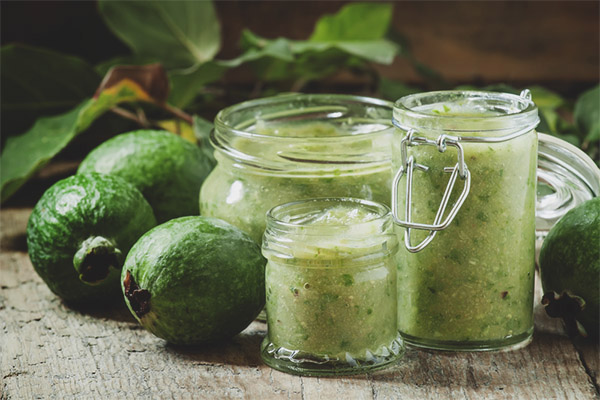
The classic feijoa jam, which was brought to a boil, can be stored for one year without placing the jars in the refrigerator. But for this you need to follow all the rules:
- Pour jam exclusively in hermetically sealed glass jars. The optimal volume is 0.5 liters so that they do not stand in the open for too long.
- Before pouring jam, the jars must be sterilized. This is done in water or steamed, no matter.
- In no case should you pour the finished jam ("live" or classic) into a moist container. You must first turn the jar upside down on a paper towel and wait until it is completely dry. To save time, you can dry the cans in the oven at a minimum temperature.
- Covers must be taken whole, without damage, with a uniform coating. Best of all - if there is a polymer layer on the metal (the so-called "white" caps - they do not oxidize).
- For live jam, which is stored for a relatively short time, you can take polymer covers. But it is recommended that you first cover the neck of the jar with parchment paper folded several times.
- The more sugar - the more lemon juice is needed, this will prevent the appearance of mold in banks. And the thicker the product, the better, because the risk of spoilage is reduced.
It is not necessary to store the cooked jam in the refrigerator. But it’s still advisable to find a cool place for him. Ideally, you will need a specially equipped pantry or cabinets on an unheated balcony. At the same time, direct sunlight should be avoided, the jam will oxidize and deteriorate faster under their influence. In a private house, feijoa jam is not recommended to be put in the cellar, because it can disappear due to the low temperature, and if the temperature drops sharply, the jar will simply “break”.
Cooked jams can be stored for at least a year. Some chefs believe that it can stand for several years, because in feijoa there are no such bones as, say, in cherries that would contain a large amount of toxic hydrocyanic acid. And if feijoa is cooked with apples, peaches or apricots, then it is recommended to remove the seeds from them. But it’s better not to risk it: a year is the best time.
Interesting facts about Feijoa
Europeans learned about the existence of feijoa only in 1815. It was discovered by German biologist Friedrich Sellov during his expedition to the jungle of Brazil. However, the plant is not named after him, but in honor of the naturalist João de Silva Feijo, who, however, also contributed to the study of Brazil. An even more interesting fact is that the naturalist himself carried the surname Barbosa, and took the pseudonym in honor of the philosopher Feijo i Montenegro, popular during the years of his youth. This is a complicated story.
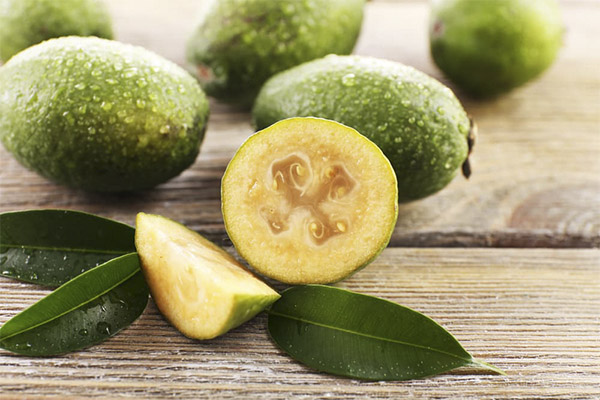
What else interesting can you say about feijoa? For example, cite the following facts:
- This plant blooms with very beautiful white flowers with a whole firework of red stamens. In the wild, it is pollinated by tiny hummingbird birds.Well, for the garden variety of feijoa, there is only an option with bees.
- Feijoa flower petals are also considered edible, they have a sweet taste. They are either added to fruit salads or dried and brewed tea with them.
- Feijoa tastes like strawberries to Europeans, and Guava to Latin Americans; in these countries, berries are often called pineapple guava.
- In Europe, feijoa began to grow in France in the 1890s, with the light hand of the French botanist Eduard Andre.
- In New Zealand, feijoa has taken root from the very beginning. Today, they get record yields of this berry. Therefore, the country has come up with many ways to process it. Feijoa is added to various non-alcoholic fruit drinks, made from it wine and cider, boiled jam and prepared "live" jam, used as a filling for pies, even made ice cream and yogurt from it. But local vodka enjoys particular success, in which, in addition to feijoa, exotic ingredients such as passion fruit, kiwi, tea tree honey are added.
- Peeling ripe feijoa fruits is quite difficult. Their flesh is tender, but the skin is tough and can sometimes ruin the taste with its acid. If the fruits are large, then they are simply cut in half, and then the pulp is taken out with a teaspoon. If you get the hang of it, you can just break the berries and squeeze the contents of the halves directly into your mouth.
- In some countries, feijoa are dried, pre-cut into slices. They can then be consumed with other dried fruits, they are also brewed as tea, like peel. And also compotes are cooked from them.
It is also interesting that in Russian the word feijoa has a feminine gender (since it is a berry like strawberries, raspberries or blueberries) and is considered an indeclinable noun. But an adjective does not form from him, no matter how much the jokers exercise wit.
«Important: all information on the site is provided exclusively in fact-finding purposes. Before applying any recommendations, consult with a profile specialist. Neither the editors nor the authors are liable for any possible harm caused materials. "

